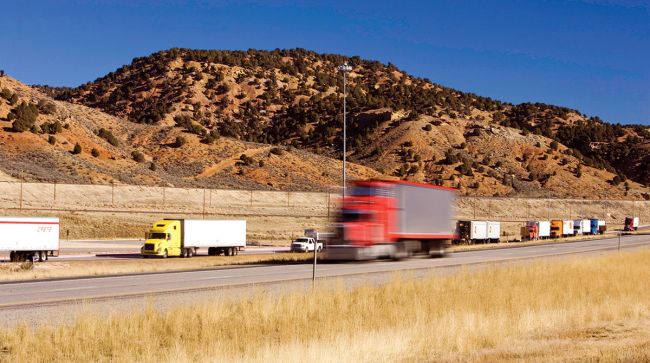A Washington think tank is encouraging the federal government to proceed with a legislatively mandated national pilot program to explore the viability of a vehicle-miles-traveled fee, a system viewed by some as a potential replacement for current federal fuel taxes on diesel and gasoline at the pump.
The Eno Center for Transportation in a new research report said that current national policy priorities that favor electrification tilt toward a future where some new vehicles would pay no federal motor fuel taxes, while vehicles with internal combustion engines would generate less fuel tax revenue as fuel economy improves.
Federal fuel taxes funnel into the Highway Trust Fund for repairs and upkeep to roads, bridges and transit. However, the HTF in the late 2000s began a period of insolvency, and has required infusions of funding ever since.
The Infrastructure Investment and Jobs Act of 2021 required the U.S. Secretary of Transportation to establish a national pilot to “test the design, acceptance, implementation and financial sustainability” of a VMT fee system. The 90-day requirement to begin that pilot passed long ago, so Eno is now urging the government to move it forward.
“Since running out of money in September 2008, the HTF has required the infusion of $272 billion in special transfers from general revenues in order to stay solvent,” the Eno report said. “In 2009, the National Surface Transportation Infrastructure Financing Commission concluded that the United States needed a new approach to transportation infrastructure funding. It recognized that alternative fuels and more efficient vehicle technology threatened the long-term stability of a financial system based on revenues generated from the federal excise tax on fuel purchases. Today, those threats to transportation funding are not only still present, they are magnified.”
Adding to the challenge is the failure of Congress to increase federal fuel taxes: These rates have remained constant since 1993 at 18.4 cents per gallon of gasoline, and 24.4 cents per gallon of diesel fuel.
What is the Highway Trust Fund? How does it work? If you’re confused, don’t worry. Check out this helpful article by Eno’s @JDwithTW that explains all the basics. 🛣️https://t.co/ViDndzEyAZhttps://t.co/vnmC1GgJdT
— Eno Center for Transportation (@EnoTrans) August 31, 2023
The IIJA mandates creation of a Federal System Funding Alternative Advisory Board that reports annually to Congress and ultimately creates recommendations for a possible permanent VMT fee. At the conclusion of a five-year pilot, Congress would then decide to either pursue a national VMT fee or other options, the report said. The pilot would build on existing pilots underway in 37 states, and focus specifically on options and potential obstacles for a VMT pilot for commercial trucks.
To inform its research report, Eno assembled a National VMT Fee Pilot Research Advisory Panel, comprising volunteer members from the public, private, nonprofit and academic sectors who have experience in transportation policy, finance, VMT fee pilot administration, trucking, automotive, tolling and more.
“A national VMT fee pilot for commercial vehicles should test various rate structures, including a fee based on gross vehicle weight rating, gross registered weight and vehicle class,” the report said. “This rate structure should be straightforward and not present undue reporting burdens for the trucking industry. Although commercial vehicles present unique challenges to international border VMT fee testing, that element does not need to be prioritized.”
A 2021 “practical analysis” of VMT fees for trucking by the American Transportation Research Institute outlined some challenges for such a system.
“It is not known what the full costs of collecting a national VMT tax would be, but the literature does make a first attempt at outlining the costs,” the ATRI analysis said. “It is clear that, as noted in one National Academies of Sciences report, there are no ‘low cost’ options that can be easily verified and enforced.”
ATRI said the administrative reality of a VMT tax system is far more complicated to track and collect money from several hundred million vehicles than collecting the fuel tax from several hundred large fuel providers. In addition, collecting revenue from a remote user group is far more complex than collecting at the point of service, as is done by tolling.
ATRI’s research noted that though user concerns often are secondary, considerations to VMT tax system planning can result in issues that could undermine the viability of a VMT tax, including a lack of full participation, general public perceptions of fairness, privacy concerns and bypassing the democratic process.
The ATRI study also highlighted a number of other VMT tax concerns:
- Rural roads, with fewer users, could receive less funding, regardless of their strategic role in connectivity.
- Urban users could argue for more transportation revenue, but will not likely see improvements in travel times due to limited opportunities to increase roadway capacity.
- A VMT tax program will move fuel tax revenue collection from fewer than 300 federal entities to 272 million vehicle accounts.
“Based on the data and information developed in this research, there are multiple challenges that must be overcome before a sustainable path forward for a national VMT tax program is available,” ATRI concluded.






